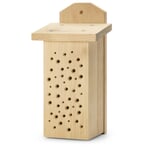Wild bee house robinia wood

Wild bee house robinia wood
- Securing diversity: Supporting wild bees and solitary wasps
- Choose weather resistance: made of solid robinia
- Protect from injury: cleanly drilled out brood tubes
General Information
Completely renovated. With new nesting tubes
Our wild bee house is now open to even more species of cavity-nesting wild bees for nesting and overwintering. Why is that? Quite simply because the number of brood tubes has increased. And that's not all, because we want to offer the smaller species in particular, which prefer narrower tunnels, opportunities for shelter. The new brood tunnels have a diameter of only 3 and 4 mm.
This means that rare wild bees such as the bellflower scissor bee or the common hole bee can also find a home. Did you know that these are oligolectic insect species? The term "oligolectic" comes from the Greek ("oligos", meaning "few, small", and "lektos", meaning "selected") and in this case stands for a selected number of plants that are preferred as food plants. The bellflower scissor bee, for example, relies exclusively on bellflowers as a food source for its survival. In contrast, the common stinging bee specializes on composite flowers as food plants, including thistle, knapweed, goldenrod, chamomile, coneflower, marigold, watercress and chicory. Our recommendation: Plant a varied supply of nectar and pollen in your garden near the spot where you are setting up your wild bee house. You should give priority to native plants. This is the best way to help wild bees: Find out in advance which (endangered) wild bee species occur in your region and design your plant and seed selection accordingly.
Incidentally, there is no risk of injury to the winged insects. When making our wild bee house from robinia wood, we take particular care to ensure that the entrance holes are as clean as possible by means of an additional countersunk hole. All holes are deburred and sanded smooth. This ensures that the wild bees do not tear their wings when moving in. Well-housed in this way, the animals contribute to the vitalization of your garden - while you make a valuable contribution to the preservation of biodiversity by setting up the wild bee house.
New home. Nesting and feeding places in the garden
Natural disorder is missing almost everywhere in our tidy landscape. There are hardly any bushes and hedges left around the large agricultural areas, and in home gardens, flowering plants are immediately pruned and cut back, leaves and prunings removed. As a result, there are fewer and fewer natural habitats for beneficial insects and, incidentally, for our native songbirds.
Nesting aids and feeders are the best way to revitalize the garden and improve the ecosystem. This allows beneficial insects to settle, making the use of pesticides superfluous and at the same time allowing illuminating observations. In this way, species protection and nature experience can be combined very easily. As the animals prefer individual formats, the choice of nesting aid can be used to promote specific species in a relatively targeted manner. Our nesting and feeding areas are made from durable and attractive materials.
Product Information
Article Number 216182
- Securing diversity: Supporting wild bees and solitary wasps
- Choose weather resistance: made of solid robinia
- Protect from injury: cleanly drilled out brood tubes
Shelter for cavity-nesting wild bees. With brood tubes in diameters of 3, 4, 5 and 6 mm. Made entirely from untreated robinia wood. Width 14 cm, depth 11.5 cm, height 27.5 cm. Weight 1.7 kg.
Have a question?
If you have a question concerning this product you are welcome to contact us. For this your E-Mail program will open.
Customer Service
Ob Beratung, Ersatzteile oder Sonderwünsche - all Ihre Fragen und Anliegen behandelt unser Customer Service persönlich und fundiert.
Sie erreichen uns von Montag bis Freitag unter der Nummer +49 2309 939095 oder jederzeit unter info@manufactum.de
Das Gartenjahr
Egal ob großer Garten oder kleiner Balkon – Antworten auf alle Fragen der Gartenarbeit finden Sie im Manufactum Gartenjahr. Nach Gartentyp und Jahreslauf gegliedert werden alle wichtigen Arbeiten leicht verständlich und Schritt für Schritt beschrieben.
Zum Gartenjahr


